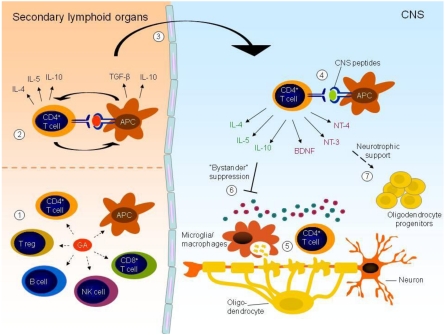Figure 1.
GA may affect several arms of the immune system, including CD4+ and CD8+ T cells, B cells, natural killer (NK) cells, regulatory T cells (T regs) and APCs (1). GA induces an anti-inflammatory profile in both APCs and T cells and these cell populations may reciprocally stimulate each other. The effect on CD4+ T cells is thought to involve recognition of GA presented on HLA class II molecules by APCs in peripheral lymphoid organs (2). Activated T cells may cross an inflamed BBB and gain access to the CNS (3). Within the CNS, reactivation of GA reactive T cells may occur through random cross reactivity with CNS peptides presented by CNS resident APCs (4) or in a T cell receptor independent fashion triggered by the persistent inflammatory environment within the inflamed CNS (5). Reactivation of GA reactive T cells within the CNS may lead to secretion of anti-inflammatory cytokines, which will dampen ongoing inflammation through “bystander suppression” (6). In addition, secretion of neurotrophic factors by activated T cells may affect neurogenesis and remyelination in the brain (7).

